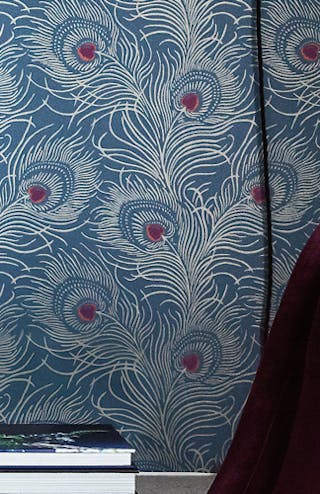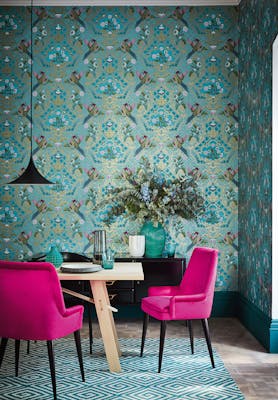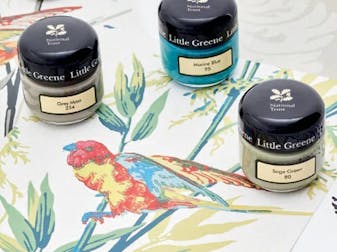
london Wallpapers V
Carlton House Terrace c. 1885
A flamboyant peacock feather design, found in the attics of 18 Carlton House Terrace, a beautiful stucco-faced London town house overlooking The Mall. Originally machine-printed in green on a yellow background, the contemporary surface-printed technique used to recreate it accurately reflects the original, whilst a judicious splash of colour in the feather provides something on which to anchor a contemporary scheme.
Marlborough c. 1915
A large-scale pattern, reminiscent of an early-20th century interpretation of one of Robert Adam’s designs. This paper was discovered just after the death of Queen Mary, who lived in Marlborough House until 1953, after which the house became the headquarters of the Commonwealth Secretariat.
Brodsworth c. 1863
A lively and engaging design featuring striking birds and delicate floral motifs. Slightly raised and incorporating rich gilding detail, the pattern was originally designed to be an imitation of stamped leather. Based on early-18th century French textiles and furnishings, encompassing panels, scrolls and cross hatching, this wallpaper was found at Brodsworth Hall in South Yorkshire, an elegant, Victorian home belonging to the Thellusson family. Used in both the library and the morning room in reverse colourways, this paper was certainly a family favourite and can still be seen in situ today.
Bedford Square c. 1900
One of the most impressive squares in London, Bedford Square was originally laid out in 1775–6 and, until World War II, the majority of its houses were inhabited by lawyers, architects, publishers and other professionals. The original of this paper was saved from a property in the square, and is of a design typical of the late 19th and early 20th centuries. New colourways include an uplifting green option that incorporates Acorn, Acorn Mid and Puck. The fresh background combined with the dark green fine line of Puck gives the design a more contemporary look and feel. There is also a pink option with a China Clay background and
soft, feminine Hellebore and Blush highlights.
St James's Park c. 1940
This large damask pattern was found in Marlborough House, next to St James’s Park, a grand abode designed by Christopher Wren and home to the Duchess of Marlborough, friend and confidante of Queen Anne. Originally a dark blue flock on a pale blue ground, the paper is believed to be comparatively recent, though the origins of the general design are Victorian (as a wallpaper) and older still (as a silk fabric). The twist in this interpretation is the light-to-dark ombré effect, which puts bolder colour at the base of the wall and lighter above, with the effect of making a space feel taller and lighter than it would with a conventional damask design. It is a panel design, with three panels making up one full repeat.
Wilton c. 1760
A classic damask design that is very typical of the popular large-scale pomegranate patterns of the mid 18th century, this would originally have been a flock wallpaper and hung in a grand English home. Flock papers were an English speciality, being in effect imitations of expensive textiles, which were nonetheless costly to produce. As a result, they came to represent a confident statement of luxury and social status.
lansdowne Walk c. 1910
An Arts & Crafts motif in the manner of Voysey, a leading light of the movement who was perhaps more famous as an architect than as a wallpaper designer. Although this colourful wallpaper was removed from a 19th century house in Kensington, its actual design dates it to the early 20th century.
Brook Street c.1895
In entirely different eras, two neighbouring houses in Mayfair’s fashionable Brook Street were homes to the baroque composer George Frideric Handel and rock musician Jimi Hendrix. Hendrix spent some of his short-lived musical career in a flat at No. 23, the same property from which this pattern hails. The woven cane-like design is typical of the late 19th century: an all-over pattern, which sits on a lightly brushed ground and incorporates a soft texture within its motif.
New Bond Street c. 1690
Based on one of the oldest surviving documents in the wallpaper archive, this fragment from an embossed leather wall hanging actually predates wallpaper. Panels of embossed and painted leather, usually with a floral pattern, were popular though expensive modes of decoration in the late 16th and 17th centuries. These panels were sewn together to create large-scale decorative hangings, in much the same way that drops of wallpaper are hung side-by-side to create a more impressive statement.
lauderdale c. 1820
This paper, a variation on a striped theme, dates from around 1820, although the original fragment was discovered in a 16th century property, Lauderdale House on Highgate Hill, overlooking Hampstead Heath. The design results from stencilling as opposed to block printing: a plain green paper would have been put up on a hessian scrim stretched over the wall and then stencilled in situ.
较低的George Street c. 1810
An abstract paper, which, despite its contemporary appearance, probably dates from the early 1800s when such designs were hugely popular. The original colourway, featuring orangey stars on a pinky-yellow ground, was discovered on an upper floor of a commercial building that had been refaced in the early 19th century but was most probably a much older building.
Monroe
The second paper in this collection taken from Brooke House in Hackney, East London. For a long period, Brooke House was home to a private hospital and this design takes its name from one of its significant 19th century owners: a Dr John Monroe. The pattern is recreated from a relatively small remnant found before the house was pulled down in the 1950s. It is undoubtedly inspired by the Art & Crafts Movement and its familiarity would have been used to help hospital patients feel comfortable and aid their recovery. Available in five colourways.
Brodsworth – Empress
The oldest source material for London Wallpapers V actually pre-dates wallpaper: a decorative piece of leather from 1690 that would have been displayed as a hanging mural rather than glued to a wall. Other remnants include hand-blocked damasks, delicate neoclassical fragments, hand-stencilled patterns and authentic designs from the Georgian and Arts & Crafts periods.Order your free wallpaper samples today




























































